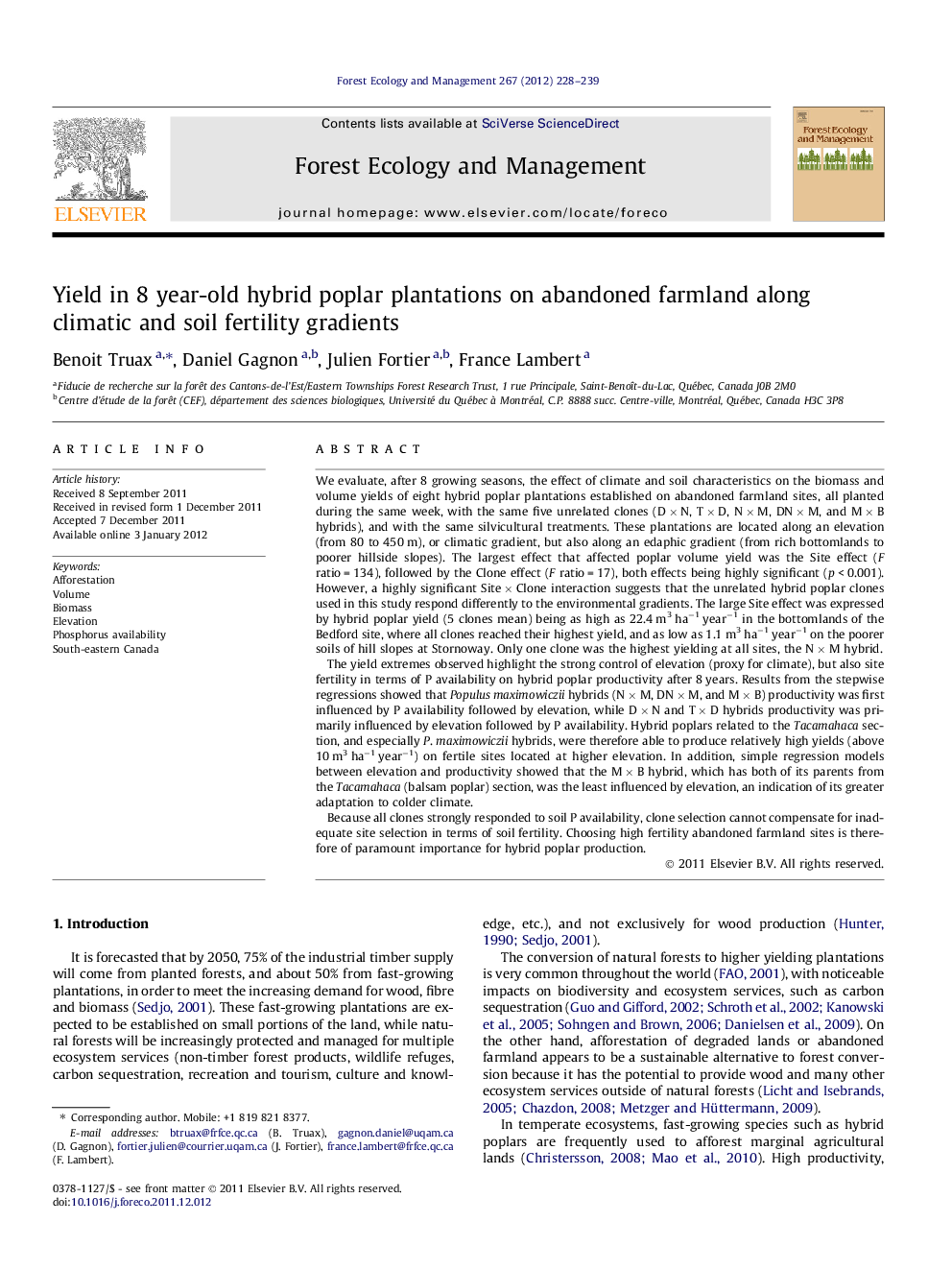| کد مقاله | کد نشریه | سال انتشار | مقاله انگلیسی | نسخه تمام متن |
|---|---|---|---|---|
| 87628 | 159258 | 2012 | 12 صفحه PDF | دانلود رایگان |

We evaluate, after 8 growing seasons, the effect of climate and soil characteristics on the biomass and volume yields of eight hybrid poplar plantations established on abandoned farmland sites, all planted during the same week, with the same five unrelated clones (D × N, T × D, N × M, DN × M, and M × B hybrids), and with the same silvicultural treatments. These plantations are located along an elevation (from 80 to 450 m), or climatic gradient, but also along an edaphic gradient (from rich bottomlands to poorer hillside slopes). The largest effect that affected poplar volume yield was the Site effect (F ratio = 134), followed by the Clone effect (F ratio = 17), both effects being highly significant (p < 0.001). However, a highly significant Site × Clone interaction suggests that the unrelated hybrid poplar clones used in this study respond differently to the environmental gradients. The large Site effect was expressed by hybrid poplar yield (5 clones mean) being as high as 22.4 m3 ha−1 year−1 in the bottomlands of the Bedford site, where all clones reached their highest yield, and as low as 1.1 m3 ha−1 year−1 on the poorer soils of hill slopes at Stornoway. Only one clone was the highest yielding at all sites, the N × M hybrid.The yield extremes observed highlight the strong control of elevation (proxy for climate), but also site fertility in terms of P availability on hybrid poplar productivity after 8 years. Results from the stepwise regressions showed that Populus maximowiczii hybrids (N × M, DN × M, and M × B) productivity was first influenced by P availability followed by elevation, while D × N and T × D hybrids productivity was primarily influenced by elevation followed by P availability. Hybrid poplars related to the Tacamahaca section, and especially P. maximowiczii hybrids, were therefore able to produce relatively high yields (above 10 m3 ha−1 year−1) on fertile sites located at higher elevation. In addition, simple regression models between elevation and productivity showed that the M × B hybrid, which has both of its parents from the Tacamahaca (balsam poplar) section, was the least influenced by elevation, an indication of its greater adaptation to colder climate.Because all clones strongly responded to soil P availability, clone selection cannot compensate for inadequate site selection in terms of soil fertility. Choosing high fertility abandoned farmland sites is therefore of paramount importance for hybrid poplar production.
Figure optionsDownload as PowerPoint slideHighlights
► Elevation and soil P availability were the primary factors affecting hybrid poplar yield.
► All clones reached their highest yield on low elevation fertile sites.
► Clone selection is a factor, although secondary, to optimise wood production along environmental gradients.
► Clones with a parent from the Tacamahaca section were better adapted to cooler climate.
► Clone selection cannot compensate for inadequate site selection in terms of soil fertility.
Journal: Forest Ecology and Management - Volume 267, 1 March 2012, Pages 228–239